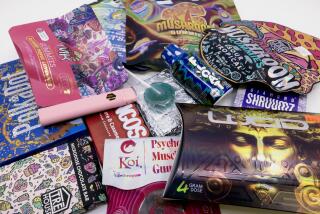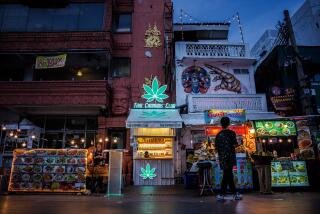‘Ice’ Age : Drugs: The seductive narcotic that ravaged Hawaii has come back to haunt Taiwan, where much of it is manufactured.
TAIPEI, Taiwan — The restless teen-ager, displaying an ugly knife scar on his leg as evidence of his experiences, told of life on the fringes of an underworld gang.
“At first they treat you very well,” he said. “They gave me money and things to eat and drink. But then they used me.”
They also hooked him on “Prince Amphetamine.”
In America, the drug is a white crystalline substance known as “ice,” a nearly pure synthetic narcotic that is chemically identical to the powdered form of methamphetamine called “speed.”
Concern over amphetamine abuse has burst into public consciousness in Taiwan only in the past year--although such abuse has existed in East Asia for decades. Indeed, ice now is believed to pose a particularly great threat here, in part because of its purity and strength compared to the traditional powder.
The seductive drug, which looks like rock sugar and has been illegally manufactured in Taiwan and elsewhere for several years, is often smuggled to Japan for distribution. It also is shipped from Asia via California and Canada to Hawaii, where the easily smokable crystals are preferred.
It offers an apparently irresistible combination: an intense, prolonged high without the use of needles. While the rush from “crack” cocaine ends within half an hour, an ice high lasts four to 14 hours. But the initial payoffs are illusory--the drug ravages the minds and bodies of its users, inducing paranoia and violence.
Ice hit Honolulu hard, quickly spreading from Filipino youth gangs to hotel workers and clerical employees, and by 1989 it was considered an epidemic in Hawaii. Aggressive law enforcement and public education have helped stem its Hawaiian spread but demand remains strong, officials say.
Although its use has worried American authorities for several years, ice was only legally classified as a narcotic in Taiwan last fall.
That action gave police strong incentive to crack down on the trade. In coordinated raids in March on three illegal drug factories in the city of Kaohsiung, police seized 1,230 pounds of ice and the raw materials for making it. The drugs were worth up to $15 million on the street, making it the largest amphetamine bust in the island’s history.
Later that month, in a raid on a second factory believed run by the same gang, police seized another 525 pounds of finished or half-processed ice and 660 pounds of raw materials, with a retail value estimated at $4 million.
The Taiwanese Ministry of Education now has initiated mandatory random drug testing in junior high and high schools. Large-scale education and advertising efforts, spearheaded by the Health Department’s Bureau of Drugs and a private health organization called the John Tung Foundation, also are under way.
“We discovered amphetamines when we sent our staff to schools to give anti-smoking speeches and anti-smoking classes,” says David D. Yen, the foundation’s president. “Students said, ‘Teacher, I’d like you to know some of us use ice. ‘ And my staff said, ‘What’s ice?’ ”
Taiwan is a major manufacturing base for ice partly because the key ingredient, ephedrine, which is used in nasal decongestant, is not hard to obtain here.
Ephedrine is tightly regulated in Taiwan, as in most Western countries. But it is under only loose control in China, according to Chang Hung-jen, deputy director of the drug bureau. As a result, large quantities are smuggled to Taiwan in fishing boats for conversion into ice.
“If you have ephedrine and the reagent and certain equipment that you can get from a high school chemistry lab, you can make it yourself,” Chang laments. “It’s very easy to set up an underground manufacturing site. All you need is someplace to hide from the police.”
Taiwan imports about 4,400 pounds of ephedrine per year for medical use, Chang adds. Last June, when Prime Minister Hau Pei-tsun started to crack down on the smuggling, “the first boat they caught with drugs had more than (2,200 pounds) of ephedrine,” Chang says. “That’s 50% of the annual legal use.”
The teen-ager in Taipei who was involved with the drug underworld, speaking on condition that he not be further identified, acknowledges that “I started taking it partly out of curiosity and partly because I was mixed up with this gang. They were older than me, in their 20s and 30s. They were drug dealers. They didn’t use drugs themselves.”
This teen-ager, who performed a variety of risky tasks for his elders, said he quit both the gang and his drug habit after being injured in a fight with rival hoodlums.
But during his two years in the underworld, he felt he could “forget all pressures” when using an kungtzu , which can be translated as “Prince Amphetamine” or “Prince Contentment.”
“You feel very light, your spirits are high, you feel great, and you hallucinate,” he said. “I could look at a glass and have it turn into a person.”
Private rooms at “KTV” or “MTV” halls, which dot the neon-lit entertainment districts of crowded Taipei, are favorite hangouts that critics say are ideal spots for pushers of ice and other drugs.
Operators of “KTV” establishments provide customers with sing-along karaoke videos, while at the “MTV” or “movie-television” halls, the fare is action or soft-porn films.
A key attraction of the parlors is the chance to escape the prying eyes of parents or neighbors--and it is an environment made for partying.
“You can buy amphetamines almost everywhere,” Yen laments. “It’s very easy. You can buy it at MTV and KTV parlors, dance halls--all of these places where young people go to enjoy themselves. In schools, students sell it to each other. . . . This is a rather cheap drug. It’s something that children can afford.”
Vials of ice, enough for one or two weeks’ use, reportedly sell on the street in Taipei for $25 to $75, depending on quality. Illegal factories sell to dealers at about $10 per vial for top-quality crystals. (In California a gram of ice goes for about $300, according to Los Angeles police, local police and U.S. officials estimate, while in Hawaii it retails for about $900.)
Once acquired, the ice habit is not easy to shake. A 30-year-old woman, who started drinking, smoking and sniffing glue when she was 16, said that for most of the past decade her life has been dominated by hallucinatory drugs and morphine, then by ice after it became readily available.
“I was sent to a psychiatric hospital,” says the woman, speaking on condition of anonymity. “The doctors said the amphetamine had damaged my brain. At that time I felt very bad. . . . Popeye, Donald Duck, they were living in my mind, and they talked to me. I really had these things inside that were constantly talking to me. I was always speaking back to them. So people nearby would say, ‘She’s really got a problem.’ . . . I was like this for two months.
“When I used amphetamines, I didn’t feel anything special,” the woman adds in a dreamy, melancholy voice. “I just felt very good and didn’t want to sleep.”
Yen, the health foundation leader, says family problems often form the backdrop to drug abuse in Taiwan. But he adds that Taiwan’s fiercely competitive educational system also contributes to an atmosphere in which ice seems attractive to some youths.
“In Taiwan we have very difficult examinations,” he said. “If you don’t pass, you can’t graduate, or you can’t get in to the next higher-level school. The pressure on tests is very great. So we’ve discovered, very strangely, that good students, in order to be even better, take a bit of amphetamine so they can study all night and get better test scores. And bad students, when they’re under all this pressure, they take it for the hallucinations. They give up on their studies.”
Yen also notes that amphetamine abuse has not been limited to teen-agers and youths looking for excitement:
“Taxi drivers want to stay awake when they drive, so sometimes they take a little--or people who work at night in factories. When factory workers have to do overtime at night to fill shipment orders, the owner may order them to work and then distribute amphetamines so they can keep going. Now our government, television, newspapers--all are saying very clearly that this must not be done.”
Chang says he believes that while the ice epidemic caught officials “quite unprepared,” Taiwanese society is so fundamentally opposed to drug abuse that the government will be able to rapidly control the problem.
Taiwan did not prosecute amphetamine cases until 1989, when 31 instances of manufacture, possession or sale went to court. Last year there were 410 cases, with 217 in the first two months of this year alone. (In contrast, Hawaiian officials say arrests in Honolulu related to ice peaked at 613 in 1989, then fell 20% last year and are holding steady.)
All Chinese, Chang asserts, are aware of the 1839-1842 Opium War, when Britain forced China to abandon efforts to stamp out the opium trade. Over the next century, opium addiction devastated Chinese society.
“It’s perceived that these drugs are bad things that destroyed the whole society and the whole nation,” Chang says. “As a society, I think, we hate drug abuse. So we can react very fast.”
Staff writer Elizabeth Venant, in Los Angeles, and special correspondent Susan Essoyan, in Honolulu, contributed to this story.
More to Read
Sign up for Essential California
The most important California stories and recommendations in your inbox every morning.
You may occasionally receive promotional content from the Los Angeles Times.










